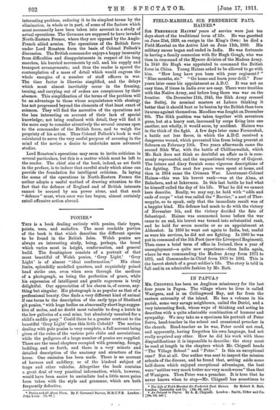FIELD-MARSHAL SIR FREDERICK PAUL HAINES.*
Sin FREDERICK HAINES' years of service were just ten days short of the traditional term of life. He was gazetted on June 21st, 1839, an ensign in the King's Own; he died a Field-Marshal on the Active List on June 11th, 1909. His military career began and ended in India. He was fortunate in having a family connexion with Sir Hugh Gough, who was then in command of the Mysore division of the Madras Army. In 1840 Sir Hugh was appointed to command the British force in China. Young Haines asked to be allowed to go with him. "How long have you been with your regiment ? " " Nine months, sir." " Go home and learn your drill." Four years later came his appointment as A.D.C. It was not an easy time, if times in India ever are easy. There were troubles with the Native Army, and before long there was war on the frontier. On December 11th, 1845, the Sikh Army crossed the Sutlej, its nominal masters at Labore thinking it better that it should beat or be beaten by the British than turn its arms against themselves. Moodkee was fought on December 8th. The Sikh position was taken together with seventeen guns, but at a heavy cost, increased by corps firing into one another, not wholly, it would seem, by accident. Haines was in the thick of the fight. A few days later came Ferozeshab, a battle not less fierce, in which the A.D.C. received a dangerous wound, which prevented him from being present at Sobraon on February 10th. Two years afterwards came the second Sikh War, with the battle of Chillia,nwallah, which Mr. Rait does not think so doubtful an affair as it is com- monly represented, and the unquestioned victory of Gujerat. The letters and diary furnish some vigorous descriptions of the fighting. The next few years were spent at home, and then in 1854 came the Crimean War. Lieutenant-Colonel Haines—this was his brevet rank—was at the Alma, at Balaclava, and at Inkerman. In this last battle he had what he himself called the day of his life. What he did we cannot here describe. Really, we may say, he held with "odds and ends of corps " what was called the " Barrier," a sort of Ther- mopylae, so to speak, only that the immediate result was of a happier kind. His defence had much to do with the victory of November 5th, and the victory decided the fate of Sebastopol. Haines was summoned home before the war came to an end, his brevet was turned into substantial rank, and he held for seven months or so an appointment at Aldershot. In 1856 he went out again to India, but, useful as were his services, he did not see fighting. In 1860 he was put in command of the 5th Foot (now the Liverpool Regiment). Then came a brief term of office in Ireland, then a year of unemployment—a quite new experience—then India again, where he was commanding the Madras Army from 1871 to 1875, and Commander-in-Chief from 1875 to 1881. This is the barest sketch of a great soldier's life. The story is told in full and in an admirable fashion by Mr. Rait.










































 Previous page
Previous page